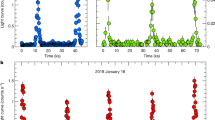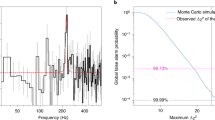Abstract
Variations in the flux from active galactic nuclei (AGN) allow the testing of models of their emission mechanisms. Various suggestions for the energy generation in AGNs require the existence of a compact object, with X rays generated deep in that object's potential well and, therefore, X-ray luminosity related directly to the object responsible for their enormous luminosities. During a 5-h X-ray observation of NGC4151 we observed a significant drop in intensity lasting ∼2,000s. The event is similar to a short flux decline previously observed1 in NGC6814. Simultaneous intensity monitoring of a quasar with coordinates close to those of NGC4151 revealed no variability in its flux, allowing instrumental causes of the event to be discounted. The short timescale of the intensity dip imposes limits of 2×107 M⊙≤M≤3×108 M⊙ on the mass of the central black hole. We suggest here that the sudden drop in intensity may have been caused by a change in the ionization state of gas clouds surrounding the black hole or, possibly, by the passage of a star across the line-of-sight in the dense nuclear region of the galaxy.
This is a preview of subscription content, access via your institution
Access options
Subscribe to this journal
Receive 51 print issues and online access
$199.00 per year
only $3.90 per issue
Buy this article
- Purchase on Springer Link
- Instant access to full article PDF
Prices may be subject to local taxes which are calculated during checkout
Similar content being viewed by others
References
Tennant, A. F., Mushotzky, R. F., Boldt, E. A. & Swank, J. H. Astrophys. J. 215, 15–25, (1981).
Bassani, L., Dean, A. J. & Sembay, S. Astr. Astrophys. 152, 52–58 (1983).
Elvis, M. Mon. Not. R. astr. Soc. 177, 7P–12P (1976).
Paciesas, W. S., Mushotzky, R. F. & Pelling, R. M. Mon. Not. R. astr. Soc. 175, 23P–27P (1977).
Auriemma, G. et al. Astrophys. J. 221, L7–L11 (1978).
Ives, J. C., Sanford, P. W. & Penston, M. V. Astrophys. J. Lett. 207, L159–L162 (1976).
Barr, P., White, N. E., Sanford, P. W. & Ives, J. C. Mon. Not. R. astr. Soc. 184, 43P–46P (1977).
Holt, S. S. et al. Astrophys. J. Lett. 241, L13–L17 (1980).
Lawrence, A. Mon. Not. R. astr. Soc. 192, 83–94 (180).
Tananbaum, H. in X-ray Astronomy (eds Giacconi, R. & Setti, G.) (Reidel, Dordrecht, 1980).
Taylor, B. G., Andresen, R. D., Peacock, A. & Zobl, R. Space Sci. Rev. 30, 479–494 (1981).
Maccacaro, T. et al. Astrophys. J. 253, 504–511 (1982).
Bignami, G. F., Caravco, P. A. & Pawl, J. A. Nature 310, 646–647 (1984).
Halpern, H. P. Astrophys. J. 281, 90–94 (1984).
Tarter, C. B., Tucker, W. H. & Salpeter, E. E. Astrophys. J. 156, 943–950 (1969).
Elliot, J. L. & Shapiro, S. L. Astrophys. J. Lett. 192, L3–L6 (1974).
Cavallo, G. & Rees, M. J. Mon. Not. R. astr. Soc. 183, 359–365 (1978).
Allen, C. W. Astrophysical Quantities 34th edn (Athlone, London, 1973).
Young, P. J., Shields, G. A. & Wheeler, J. C. Astrophys. J. 212, 367–382 (1977).
Author information
Authors and Affiliations
Rights and permissions
About this article
Cite this article
Whitehouse, D., Cruise, A. EXOSAT observations of a 2,000-s intensity dip in Seyfert galaxy NGC4151. Nature 315, 554–555 (1985). https://doi.org/10.1038/315554a0
Received:
Accepted:
Issue Date:
DOI: https://doi.org/10.1038/315554a0
Comments
By submitting a comment you agree to abide by our Terms and Community Guidelines. If you find something abusive or that does not comply with our terms or guidelines please flag it as inappropriate.



